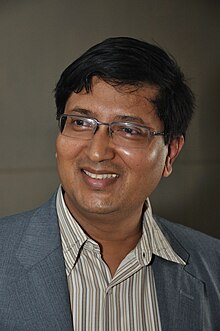Sandip Chakrabarti is an Indian astrophysicist. He developed a computer model to show how life on earth could have originated in outer space.[1]
Sandip Chakrabarti | |
|---|---|
 Sandip Chakrabarti | |
| Born | 15 November 1958 |
| Nationality | Indian |
| Citizenship | Indian |
| Alma mater | University of Chicago (Ph.D) IIT Kanpur (M.Sc) Ramakrishna Mission Residential College, Narendrapur (B.Sc) |
| Known for | Research in Black Hole Astrophysics, low cost balloon borne science, Astrochemistry leading to biomolecules, ionospheric science and earthquake predictions. |
| Awards | Received DSc from University of Gour Banga, Received Banga Ratna from Government of West Bengal. |
| Scientific career | |
| Fields | Astrophysics |
| Institutions | Director and Distinguished Professor at Indian Centre for Space Physics, Kolkata |
| Doctoral advisor | W. David Arnett, University of Chicago |
Education
editHe started his education in Lalit Mohan Shyam Mohini High School in Malda. After finishing his Bachelor of Science from Ramakrishna Mission Residential College, Narendrapur[2] in Physics Honours in 1979 (and becoming topper of Calcutta University[3]) he went to IIT, Kanpur to complete his M.Sc. Degree in Physics in 1981. He joined the Physics Dept. of the University of Chicago in 1981 to complete PhD work. Soon he completed a paper with Robert Geroch and X.B. Liang on a Theorem on "Time like Curves of limited acceleration in General Relativity",[4] and under S. Chandrasekhar's supervision solved the Dirac equation for massive particles with spin in Kerr geometry.[5] Subsequently, he concentrated on black hole astrophysics, received his Ph.D. in 1985 and went to Caltech as a R.C. Tolman Fellow.[6] Major work in this period includes finding Natural Angular Momentum distribution of barotropic flow around black holes,[7] nucleosynthesis around black holes.[8][9]
Career
editAfter a brief period at ICTP, Trieste, where Chakrabarti completed a few definitive work on the formation of shocks in transonic/advective flows around black holes, he joined Tata Institute of Fundamental Research, and S.N. Bose National Centre. Currently, he is the Director of Indian Centre for Space Physics,[10] Kolkata, which he founded in 1999. He was at NASA Goddard Space Flight Centre (1994-1995) as a Senior Associate selected by National Research Council.
Research
editThe main focus of Chakrabarti's research is the hydrodynamic and radiative properties of astrophysical flows around black holes and other compact objects. He showed that the accreting matter must be transonic[11] and should have standing, oscillating and propagating shocks. He and his collaborators studied many aspects of these flows and showed that the black hole accretion must have non-Keplerian component which plays a major role in deciding the observational properties. He wrote the first monograph on "Theory of Transonic Astrophysical Flows"[12] (World Scientific Pub. Co., Singapore; 1990). He has completed over 650 research articles and written or edited several books and conference volumes.[13] Forty Eight students have completed Ph.D. Thesis under his supervision.[13]
Chakrabarti was the first scientist to suggest that Gamma-ray bursts are the birth cry of black holes at his presentation in 1995, third Huntsville, Alabama Conference.[14] In 2013, Scientists observed a conclusive evidence of this birth cry.[15] He is also the first to suggest (1992-1996) that the accretion disks in an extreme mass ratio binaries could change the gravitational wave signals.[16]
References
edit- ^ Britt, Robert Roy (24 January 2000). "How Comets Might Seed Planets". Space.com. Retrieved 31 August 2010.
- ^ "RKM,Narendrapur".
- ^ Calcutta University, Kolkata. "Calcutta University".
- ^ Chakrabarti, Sandip; Geroch, Robert; Liang, Can-bin (March 1983). "Timelike Curves of Limited Acceleration". Journal of Mathematical Physics. 24 (3): 597–598. Bibcode:1983JMP....24..597C. doi:10.1063/1.525733.
- ^ Chakrabarti, Sandip (January 1984). "On Mass-Dependent Spheroidal Harmonics of Spin One-Half". Proceedings of the Royal Society of London, Series A. 391 (1800): 27–38. Bibcode:1984RSPSA.391...27C. doi:10.1098/rspa.1984.0002. S2CID 120673756.
- ^ "The Telegraph Newspaper Report". Archived from the original on 3 February 2013. Retrieved 25 December 2012.
- ^ Chakrabarti, Sandip (January 1985). "The natural angular momentum distribution in the study of thick disks around black holes". Astrophysical Journal. 313: 674–688. Bibcode:1985ApJ...288....1C. doi:10.1086/162755.
- ^ Jin, L.; Arnett, W. D.; Chakrabarti, S. K. (September 1985). "Detailed Numerical Calculations of Nucleosynthesis in Thick Accretion Disks Around Black Holes". Bulletin of the American Astronomical Society. 17: 856. Bibcode:1985BAAS...17..856J.
- ^ Chakrabarti, Sandip; Jin, L.; Arnett, Arnett, W.D. (February 1987). "Nucleosynthesis inside Thick Accretion Disks around a Black Hole. I. Thermodynamic Conditions and Preliminary Analysis". Astrophysical Journal. 288: 674. Bibcode:1987ApJ...313..674C. doi:10.1086/165006.
{{cite journal}}: CS1 maint: multiple names: authors list (link) - ^ "Webpage of Sandip K Chakrabarti at ICSP website".
- ^ Chakrabarti, Sandip (December 1989). "Standing Rankine-Hugoniot shocks in the hybrid model flows of the black hole accretion and winds". Astrophysical Journal, Part 1. 347: 365–372. Bibcode:1989ApJ...347..365C. doi:10.1086/168125. ISSN 0004-637X.
- ^ Chakrabarti, Sandip (1990). Theory of Transonic Astrophysical Flows. Theory of Transonic Astrophysical Flows. Edited by Chakrabarti Sandip K. Published by World Scientific Publishing Co. Pte. Ltd. Bibcode:1990ttaf.book.....C. doi:10.1142/1091. ISBN 978-981-02-0204-0.
- ^ a b "SKC_biodata" (PDF).
- ^ Chakrabarti, Sandip (1995). ARE GAMMA RAY BURSTS THE 'BIRTH CRY' OF BLACK HOLES?. 3rd Huntsville Symposium on Gamma-Ray Bursts. Hunsville, Alabama. M-P17. Archived from the original on 2 March 2013.
- ^ Chakrabarti, Sandip (January 2013). "Hindustan Times Link". Archived from the original on 12 January 2013.
- ^ Chakrabarti, Sandip K. (March 1996). "Gravitational wave emission from a binary black hole system in the presence of an accretion disk". Physical Review D. 53 (6): 2901–2907. arXiv:astro-ph/9603117. Bibcode:1996PhRvD..53.2901C. doi:10.1103/PhysRevD.53.2901. PMID 10020290. S2CID 36096244.